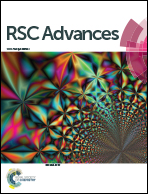Understanding the role of phosphate in the photoelectrochemical performance of cobalt-phosphate/hematite electrode systems
Abstract
The complex of cobalt-phosphate (CoPi) is known to be an efficient catalyst that can greatly enhance the photoelectrochemical (PEC) performance of hematite electrodes. However, the complicated role that associated Pi plays in the CoPi catalyst is not yet fully understood. In this study, we noted that the photocurrent density–voltage curves between Co and CoPi associated hematite electrodes are rather different, particularly in the tailings and transient spikes. This means that the reduction in the recombination loss by the associated Pi could probably result from its high electronegativity and tendency to withdraw photoexcited electrons from hematite. The results from additional surface complexation modeling and FTIR analyses further indicate that the conformation of the associated CoPi complexes also directly affect the efficiency of the withdrawal. Interactions between Co and the neighboring Pi would, on the other hand, induce the development of the CoPi catalyst to fine particles or continuous CoPi layers, which would indirectly influence their PEC performance due to the size effect. Based on our results, associated Pi in CoPi catalysts mainly influences PEC performance by withdrawing photoexcited electrons and reducing the size of CoPi catalysts.


 Please wait while we load your content...
Please wait while we load your content...